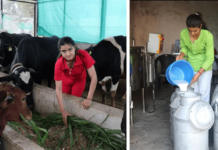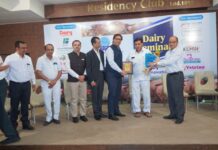By Jessie Hesseling, DVM in training at Utrecht University and Gerwen Lammers, PhD Intracare BV, The Netherlands
Udder cleft dermatitis (UCD), also known as foul udder or intertrigo, is an inflammation of the udder skin and its surroundings. It is often located between the front teats and at the transition of the front quarters and the abdominal wall. Although this condition is well known in the dairy industry, not much research has been performed. Characteristics of UCD are erythema, scabs, transudate and a foul odor. In severe cases, UCD appears as an open wound with necrosis and hemorrhage. When the mammary vein gets lacerated, UCD can lead to death. UCD is mostly diagnosed during milking or hoof trimming and is more frequently seen in older cows in all lactation stages. The consequences of UCD are an impaired animal welfare,reduced milk production and affected milk quality. Also, UCD can lead to premature culling. UCD is seen on 80% of the Dutch dairy farms, of which herd prevalencesfrom 22 up to 51% are reported. A high milk yield, digital dermatitis, sarcoptic mange, mastitis and the conformation of the udder are suggested as risk factors for the development of UCD.
UCD-lesions heal poorly and show similarities to human pressure ulcers; both show delayed healing, which is a consequence of cellular and molecular imbalance in the wound. The size of the wound has an effect on the likelihood of improvement, it is therefore important to detect and treat lesions early. Also, a high parity negatively affects the healing of UCD-lesions; cows with a parity of 5 or older, showed a significantly lower healing rate.
Current treatment options for UCD are limited
Scientific research into treatment options for UCD in dairy cows is limited. A randomized clinical trial by Van Werven et al. (2018) reports no effect of treating mild lesions with a barrier film. Daily treatment of more severe lesions with an enzyme alginogel for 12 weeks resulted in a 3.4 times more likelihood to improve (but not heal), compared with an untreated control group.Other available literature about the treatment of lesions or dermatitis in dairy cows is related to Digital Dermatitis (DD). DD is an important cause of lameness worldwide and is, in contrast to UCD, contagious. The characteristic acute lesions are ulcerative and painful for the cow.
The potential of chelated copper and zinc
Several scientific studies on the treatment of DD have been published. Treatment with a spray or gel from Intracare containing copper and zinc chelates has been proven successful several times, reporting a clinical cure of acute DD-lesions of 92.0, 86.8 and 79.0% (Holzhauer,2011; Dotinga, 2017; Jacobs, 2018, respectively).Chelated copper is antimicrobial, while chelated zinc stimulates regeneration of the skin and restoration of the epidermis. These characteristics of chelated copper and zinc based productsmay also have a potential for the treatment of UCD, and a spray is easy to use.
The aims of this longitudinal study were to determine the incidence and duration of UCD-lesions in a Dutch dairy herd and to evaluate the effect on improvement and healing of UCD-lesions of a spray containing chelated copper and zinc(Intra Repiderma).
Farm and study characteristics
The study was carried out on a Dutch dairy farm with approximately 250 pure Holstein Frisian breeds in milk located in the south of The Netherlands. The study was performed from April to June 2020 and lasted12 weeks, based on previous research of Bouma (2016), that showed a median observed duration of 8.8 weeks for mild UCD-lesions and 16.2 weeks for severe UCD-lesions.
The cows were housed indoors in cubicles, whole year round. First- and second parity cows were housed separately from the older cows. The cubicles were covered with matrasses, lime powder and sawdust and cleaned out twice a day. Cows were milked twice a day in a conventional milking parlor. The production level was 11,000 kg of milk/cow-year and the bulk milk somatic cell count varied between 95,000 and 162,000 cells/mL in the last 12 months.
UCD classification
A scoring system described previously by Van Werven (2018) was used (Figure 1). Score 0 describes a healthy udder with no signs of UCD. Score 1 describes a mild UCD-lesion with erythema, transudate, crust or scabs and an intact skin integrity. Score 2 describes a severe UCD-lesion; an open wound <5 cm, necrosis, exudate, granulation tissue and blood clots. Score 3 describes a severe UCD-lesion as well, but the size of the wound is >5 cm.
Figure 1. Schematic overview of UCD classification used, applied treatment schedule and definition of improvement and cure.
Design of the longitudinal study
All lactating cows were examinedweekly for the presence and severity of UCD. The examination was performed in the milking parlor during milking, using a mirror glued on a spatula and a head light (Figure 2A). All data was collected by the same researcher (J.H.)during the entire study period, avoiding any inter-observer variation. A cow was selected for treatmentif the UCD-score was 1, 2 or 3. The lesion was first cleaned and dried with a towel, then the whole lesion was covered with the copper and zinc chelates spray (Figure 2B).Cows with score 1 were treated every other day, while cows with score 2 and 3 were treated daily. New cases of UCD found during the study period were included in the treatment protocol as described above.
Figure 2. (A) The examination of the udders was done during milking in the milking parlor, while using a mirror glued on a spatula and a head light. (B) Application of the copper and zinc chelate spray. (C) Example of a healing UCD lesion.
Assessment of improvement and healing
The data was analyzed for the time in weeks to first improvement and healing (Figure 1). Improvement was defined as the transition of an initial score 1 to a score 0 (healed); the transition of an initial score 2 to score 1 or 0; and transition of an initial score 3 to score 2, 1 or 0. Healing was defined as the transition of any initial score to score 0. Since new cases were allowed to enter the study during the data collection period, time to first improvement and time to healing of lesions was determined for all cases of UCD that were seen at least six times during the study period. The median time to first improvement or healing was determined as the week in which the 50th percentile of the animals showed first improvement or healing.
Improvement and healing of UCD lesions
During the first visit, 42 cows of 262 examined cows had UCD and were thus selected for treatment. Of these 42 cows, 17 had score 1, 15 had score 2 and 10 had score 3. Figure 3 summarizes the UCD-scores from week 2 to 12. During this period the incidence of UCD decreased from 17.8% to 9.6%.
Figure 3. Summary of the UCD-scores during the trialfrom week 2to 12.
During the 12 week study period, 63 unique cases of UCD were found and treated. Of these 63 unique cases, 53 cases were seen at least six times during the study period and included in the analysis to determine the time to first improvement and time to healing (Table 1).
| UCD-score | No. of animals | Improved % (n) |
Median time to first improvement (weeks) | Healed % (n) |
Median time to healing (weeks) |
| 1 | 22 | 81.8 % (18) | 4 | 81.8 % (18) | 4 |
| 2 | 19 | 94.7 % (18) | 2 | 68.4 % (13) | 3 |
| 3 | 12 | 83.3 % (10) | 5 | 8.3 % (1) | 1 |
| Total | 53 | 86.8 % (46) | 3 | 60.4 % (32) | 4 |
Table 1. Number of animals and time to first improvement and healing of udder cleft dermatitis (UCD) after treatment with chelated copper and zinc spray.
Of the 22 animals with UCD-score 1, 18 (81.8%) animals experienced complete healing of the lesion, with a median time to this observation of 4 weeks (range 1-11 weeks). Of the animals that entered the study with UCD-score 2, 18 animals improved (94.7%) and 13 animals eventually healed (68.4%). The median to first improvement and healing was respectively 2 (range 2-5) and 3 (range 1-10) weeks.Twelve animals with UCD-score 3 were treated and 10 animals (83.3%) showed improvement, of which one animal completely healed. The median time to first improvement of the animals with UCD-score 3 was 5 weeks, with a range of 1-10 weeks.
Practical use of chelated copper and zinc spray on UCD
This is the first large-scale study that demonstrates the efficacy of the non-antibiotic chelated copper and zinc spray (Intra Repiderma) on UCD lesions. Treatment of mild UCD cases (score 1) every 2 days resulted in 81.8% healing with a median time to healing of 4 weeks. More severe lesions (score 2 and 3) will requirea more intensive treatmentprotocol to reach acceptable healing rates. The previously published trial of Van Werven shows that 32% of untreated severe lesions improved (not healed) spontaneously and their daily gel treatment increased this improvement rate to 60%. Our spray application reached a 83.3% (UCD score 3) to even 94.7% (UCD score 2) improvement rate. These promising results encourage to further investigate different treatment approaches using chelated copper and zinc to reach also complete healing of these severe cases.
Early detection and prevention are of utmost importance
Our results alsoemphasize that the early detection of UCD is key for a good clinical outcome. The incidence of UCD on a farm is often underestimated, particularlyon milking robot farms. Therefore, it is strongly recommended to regularly check the udders of all animals using for example an inspection mirror. Clean and dry any affected skin areas and evenly cover with chelated copper and zinc spray from a distance of ±15 cm at least every other day until completely normal.
References are available upon request
Corporate Comm India (CCI Newswire)

































